
The 1st “Wind Phone” Music Festival Live & Talk was held on April 29th and 30th. Both days were blessed with good weather, and I was able to spend a rich day while bathing in the sunlight leaking through the leaves. We would like to express our sincere gratitude to everyone involved.

This music festival was planned as a music festival “in the disaster area”, “by the victims”, and “for the victims”. It is a handmade music festival that was realized with the cooperation of the performers, with the three people in the disaster area (Sasaki, Okubo, and Dai) forming an executive committee and planning it. What all three of us have in common is that we don’t have money. Therefore, I asked all the performers if it was okay without transportation, accommodation, and performance fees.
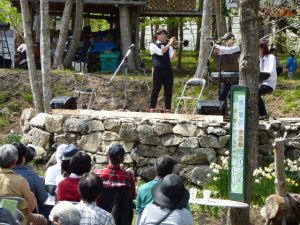
We believe that the “reconstruction of the heart” that we are aiming for is to regain the motivation that each and every one of the disaster-stricken areas had before the earthquake, even if it was small, with dreams and hopes for the future. The disaster area is now seeking a “bright future image.” A “bright future image” begins with dreaming. It takes a driving force to envision what it should be. Culture and art, including music, have the power to create dreams. I believe that what culture and art should do is to deliver dreams.
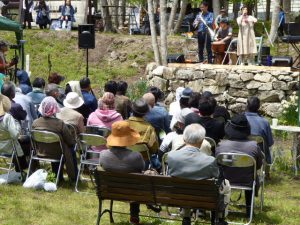
Kenji Miyazawa, who was born from the climate of Iwate, must be bright and enjoyable, not just the painful labor of farmers suffering from repeated cold and drought damage. And did music and theater activities. Seven years have passed since the disaster, but many people still have a hard time with the sadness of loss. It exactly coincides with Kenji’s time. I would like to convey the importance of being close to, sharing, and supporting the sadness of those who are suffering with everyone who participated in this music festival.

This time, there were participants from Wakayama, Osaka, and Aichi prefectures in the distance. In addition, all the performers who understand the appearance with the lunch box will be disappointed. Michiko Sato, a poet from Osaka, Sachiko Hotta, a chanson singer from Nagoya, jazz rushed from Miyagi, Hiroyuki Kanazaki, a chanson pianist, Takahiro Tatsumi, a jazz trumpeter from Tokyo, and Reiyoshi Sunagawa, a jazz pianist. And the local Omaki musician NORISHIGE, the kids choir Agudo Mame, the children’s violin classroom El Systema, the brass band Otaki Wind Orchestra, the group Cosmis from Kamaishi, the Black Camalins, and the Japanese musical instrument player. Masato Okubo Thank you very much and thank you for your hard work.
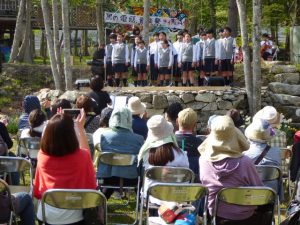
After all the performers were finished, the party with participants and performers was even more exciting. The artists promised each other a session, and they were asked to perform in other areas, when they would do it next time, and so on.

The second day was a lecture by myself and Michiko Sato. The content of my lecture was “From Wind Phone to Kenji Miyazawa”. “Wind Phone” is a phone that conveys your feelings to people who can no longer meet. It is a world of sensibility and imagination, and by nurturing them, anyone can regain the stability of their mind from the state of despair. And everyone can understand that they are necessary for living. Also, the Mori Library is not just a place to read books, but a place to read and play books, and to encourage people to learn by themselves while playing. You will develop your sensibility, see what you cannot see, listen to what you cannot hear, and begin to think about things from various angles, and you will be able to understand the essence of things. The connection with Kenji Miyazawa is that all human beings are a part of nature and live as human beings from nature, and we must coexist with nature such as how to interact with animals and plants and how to preserve agricultural products. We in the disaster area are now able to live with the help of many people. We are responsible for those who have died unfortunately and how we must live for the children who will be born. Kenji Miyazawa’s “altruistic spirit” is one of the guideposts, and he said that he must aim for a way of life that is useful for others and that if there is a person who is suffering, he will reach out.
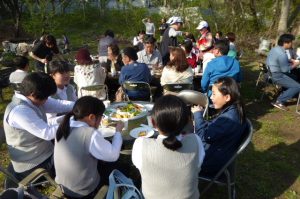
In addition, Michiko Sato’s poetry is based on the poetry of “Stone from Heaven” with the theme of the Great East Japan Earthquake, and a poem of 5 to 5 meters is exhibited at the venue. He talked about the thoughts and background of the time. One of Sato’s works, “From the wound”, is from being hurt / noticing / building from being noticed / forming a bond in the process of building / from the tearing of the wound / new self is born / life is gradually / Standing up … was being shown. Mr. Sato and I have different ways of expressing, but we both have the same sensibility and appealed that we must develop that sensibility.
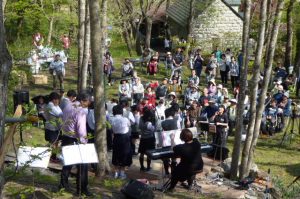
The two-day participants counted more than 300 people, including those coming and going, and were able to gain the sympathy of more than expected people. We would like to thank the performers, participants, the volunteers of the Shumeikai who helped us, and the Kenji Miyazawa Study Group. In addition, the Christmas rose seedlings provided by the Kamagaya Flower Gifting Association in Chiba Prefecture are sold at a bargain price, and the total of 40,000 yen in sales and on-site donations is the activity fund for creating a music hall in the mallet and the mallet Miyazawa. We will use it in half as a fund for the construction of the poetry monument of the Kenji Study Group. We would like to thank you again for holding a meaningful and fun music festival live and talk with your cooperation. Thank you.
